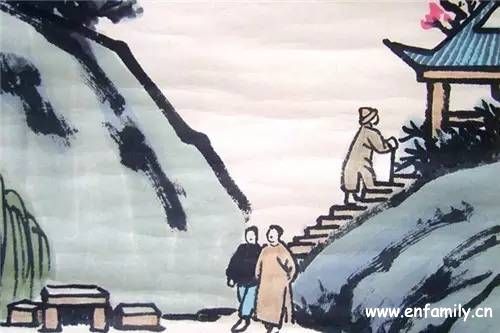可知春徒美其名,在实际生活上是很不愉快的。实际,一年中最愉快的时节,是从暮春开始的。就气候上说,暮春以前虽然大体逐渐由寒向暖,但变化多端,始终是乍寒、乍暖,最难将息的时候。到了暮春,方才冬天的影响完全消灭,而一路向暖。寒暑表上的水银爬到temperate上,正是气候最temperate的时节。就景色上说,春色不须寻找,有广大的绿野青山,慰人心目。古人词云:“杜宇一声春去,树头无数青山。”原来山要到春去的时候方才全青,而惹人注目。我觉得自然景色中,青草与白雪是最伟大的现象。造物者描写“自然”这幅大画图时,对于春红、秋艳,都只是略蘸些胭脂、硃磦,轻描淡写。到了描写白雪与青草,他就毫不吝惜颜料,用刷子蘸了铅粉、藤黄和花青而大块地涂抹,使屋屋皆白,山山皆青。这仿佛是米派山水的点染法,又好像是Cezanne风景画的“色的块”,何等泼辣的画风!而草色青青,连天遍野,尤为和平可亲,大公无私的春色。花木有时被关闭在私人的庭园里,吃了园丁的私刑而献媚于绅士淑女之前。草则到处自生自长,不择贵贱高下。人都以为花是春的作品,其实春工不在花枝,而在于草。看花的能有几人?草则广泛地生长在大地的表面,普遍地受大众的欣赏。这种美景,是早春所见不到的。那时候山野中枯草遍地,满目憔悴之色,看了令人不快。必须到了暮春,枯草尽去,才有真的青山绿野的出现,而天地为之一新。一年好景,无过于此时。自然对人的恩宠,也以此时为最深厚了。

From this we know that spring is not worth such a beautiful name, for in practical life it is rather unpleasant. Actually, the most pleasant season of the year begins in late spring. So far as weather is concerned, although in general it becomes warmer and warmer, it varies frequently. There is always the abrupt change from warmth to cold, we can find no time without weather change. It is until late spring when the influences of winter have completely disappeared that it gradually becomes warmer and warmer. When the mercury in the thermometer rises to temperate, it is just the temperate season. So far as the scenery is concerned, there is no need to seek out a spring scene, for there is a vast expanse of green hills which are pleasant to the eyes. An ancient poem goes: “The song of cuckoo symbolizes spring’s departure and hills turn green above the treetops.” It turns out that only when spring has gone will the hills become green and attractive. In my opinion, among the natural scenery, green grass and white snow are the greatest of phenomena. When God depicts nature on a huge scroll, he paints the red spring and colourful autumn with only a dab of carmine upon his brush and a little touch upon the paper. But when he paints white snow and green grass, he would spare no dye to immense his brush in the white lead powder, gardenia and cyanine and paint in big strokes, making all the houses white and all the hills green. It seems like the “details-adding method” of landscape painting at the Michelangelo School and also like the “colour chunk method” of Cezanne landscape painting. What a pungent style it is! The vast expanse of green grass is especially affable and unselfish. Sometimes the flowers are secluded within the private yards, and having suffered from their private penalty by the gardeners, they apologize to the ladies and gentlemen, while grass can grow anywhere it likes with no distinction between superior and inferior classes. Everyone thinks that flowers are the product of spring. Actually, the work of spring lies not in flowers but in grass. How many people can enjoy flowers? But grass grows freely across the fields, and is generally accepted and appreciated. This kind of beautiful scenery is seldom seen in early spring. For then the fields are covered with dry grass, a desolate scene fills our eyes and gives us nothing but an unpleasant sensation. It is only in late spring when dry grass is replaced by lush fields and real blue mountain and green fields that the world would take on a new look. The view at this time of the year is the finest. And the kindness to man bestowed by Nature is the deepest.

讲求实利的西洋人,向来重视这季节,称之为May(五月)。May是一年中最愉快的时节,人间有种种的娱乐,即所谓May-queen(五月美人)、May-pole(五月彩柱)、May-games(五月游艺)等。May这一个字,原是“青春”、“盛年”的意思。可知西洋人视一年中的五月,犹如人生中的青年,为最快乐、最幸福、最精彩的时期。这确是名符其实的。但东洋人的看法就与他们不同:东洋人称这时期为暮春,正是留春、送春、惜春、伤春,而感慨、悲叹、流泪的时候,全然说不到乐。东洋人之乐,乃在“绿柳才黄半未匀”的新春,便是那忽晴、忽雨、乍暖、乍寒、最难将息的时候。这时候实际生活上虽然并不舒服,但默察花柳的萌动,静观天地的回春,在精神上是最愉快的。故西洋的“May”相当于东洋的“春”。这两个字读起来声音都很好听,看起来样子都很美丽。不过May是物质的、实利的,而春是精神的、艺术的。东西洋文化的判别,在这里也可窥见。
The practical westerns have always paid attention to this season: they call it May. May is the most pleasant time of the year. There are various kinds of festive occasions in the human world, including the May-queen, the May-pole, May-games, etc. Originally, the word May means “youth” and “vigour”. From this we can see that westerners regard the month of May as the youth of a man, the most pleasant, happiest and the most excellent period of one’s life. It is really worthy of the name. However, easterners hold a different view: they call it late spring. It is a time of asking spring to stay, sending spring off, cherishing spring, grieving for spring and a time of sighing, grieving and sobbing. It’s no time for pleasure at all. The pleasure of easterners is in the new spring when half of the green willows begin turning yellow. It is a time of sudden shine, sudden rain, now warmth and now cold. One can never see time without change. Actually, at this time of the year, life is by no means comfortable. It is only through a careful examination of the budding of flowers and willows and a close examination of the arrival of spring in nature that we can have a pleasant sensation in our hearts. Thus, May in the western world is actually equal to Spring in the east. These words are both pleasant to the ears and good-looking to the eyes. But while May implies material and profit, Spring is spiritual and artistic. From this we can get a hint of cultural distinctions between the east and the west.
|
|